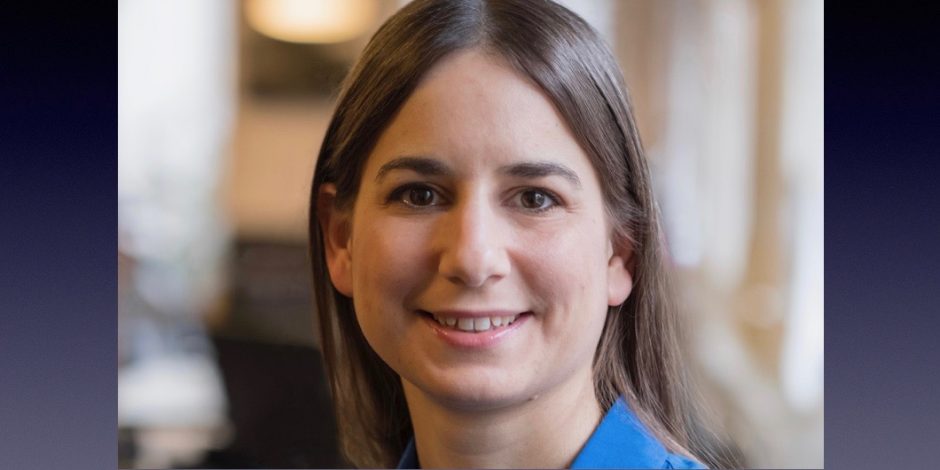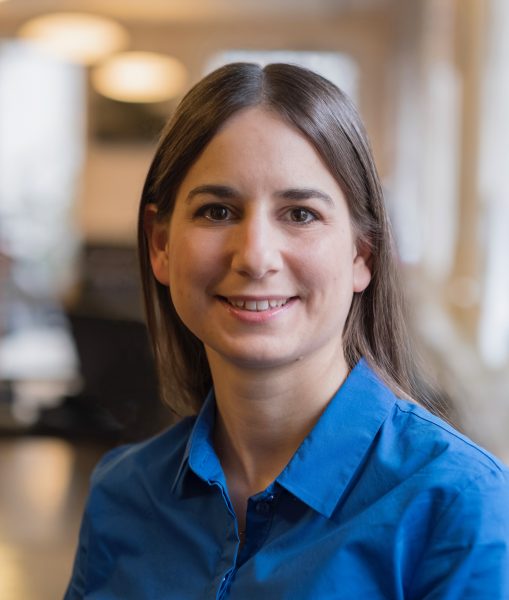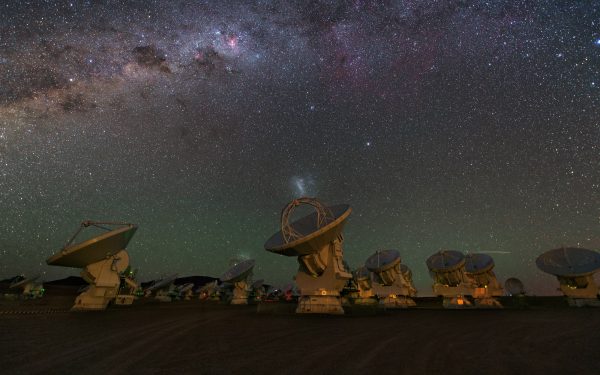Searching for the building blocks of life in space

Using radio telescopes, Susanne Wampfler investigates areas far away in space where new stars and planets are forming. The astrophysics assistant professor works at the Center for Space and Habitability (CSH) of the University of Bern and leads a PlanetS project. As the CSH’s Equal Opportunities Officer, she advocates for both women and men.

Susanne Wampfler is CSH Eccellenza Professorial Fellow at the University of Bern. (Photo Vera Knöpfel, University of Bern)
She was told that “Moon” was one of the first words she was able to pronounce as a toddler, says Susanne Wampfler. A few years later, she surprised her parents on a night trip from Vienna back home to Aargau. Instead of sleeping, she watched the sky and asked: “Why does the Moon always accompany us?” Even when the family had passed through the Arlberg tunnel, it was there again, although it had not been present in the tunnel – a mystery that puzzled the little girl.
Today, Susanne Wampfler looks even further out into space. She is a radio astronomer, her areas of expertise are star formation and astrochemistry. “In astrochemistry, we study the composition of the material from which stars and planets form,” explains the professor at the Center for Space and Habitability (CSH) at the University of Bern. The radio telescopes that Wampfler uses to observe the star formation regions do not provide colorful images, but a spectrum, i.e. the radiation of the targeted object is split into the different wavelengths. “We can often extract more information from a spectrum than from images, even though images are obviously more fascinating to the public,” says the scientist.
“Unfortunately, most people know little about radio astronomy, so I try to explain what we do in public talks,” says Wampfler. Every molecule produces a specific signature in the spectrum. This enables researchers to find out which molecules are present in the gas around newly forming stars, how common they are and what processes create and potentially destroy them again. The big goal is to find answers to the question of whether the chemical building blocks of life already exist around young stars, and if so, when and where they are formed. Astrochemists have already found organic molecules such as methyl chloride or simple sugars, but the desired detection of the simplest amino acid glycine is still pending.
Snowed in on the Gornergrat
Already during her physics studies at ETH Zürich, Wampfler was fascinated by the formation of stars and planets. However, she chose radio astronomy more by chance when she was looking for a project for her diploma thesis and was offered the opportunity to work with the KOSMA radio telescope installed on the Gornergrat by the University of Cologne until 2010. Together with a fellow student, Wampfler carried out measurements at the station located 3100 m above sea level for three weeks – under tough conditions: “We were snowed in and had barely enough to eat because the hotel was closed and we could not get down into the valley,” she remembers.
But the work impressed the supervising professor Arnold Benz, and he offered his student a PhD position. So, the newly graduated physicist stuck with radio astronomy. After her dissertation at ETH Zurich, she accepted a post-doc position at the University of Copenhagen. There she was able to get acquainted with the latest technology used in the giant ALMA telescope in the Chilean Atacama Desert. The facility at 5000 m above sea level consists of 66 parabolic antennas which are connected to form a so-called interferometer .

The Atacama Large Millimeter/submillimeter Array ALMA in Chile. (Photo ESO/Y. Beletsky)
With the relocation to Denmark, a difficult time began for Wampfler. Her partner, also a physicist, stayed in Switzerland, and in addition to the stress and strain of a long-distance relationship, the young woman also faced some critical comments for her decision to do a postdoc.
Tackling outdated role models
Since 2016, she has been back in Switzerland. After a CSH fellowship at the University of Bern, she was awarded an assistant professorship by the Swiss National Science Foundation supporting highly qualified young researchers. But even today she is still often confronted with outdated role models, for example when she attends an event together with her partner, who is also a professor: “Some people look at me strangely when they find out that I am an astrophysicist.”
It seems that this occupation and the professorship are still associated with an older man rather than a younger woman – a perception that Wampfler experienced after a TV interview on Swiss television’s 10vor10 program. The 38-year-old had competently answered questions about the moon landing anniversary. But besides positive reactions, she also received emails in which it was doubted that such a young woman could already be an expert on astrophysics. “Apparently, certain people felt provoked by my appearance on the news broadcast,” says the astrophysicist.
As CSH’s gender equality representative, she tries to ensure equal opportunities for everyone in the academic environment. She pays particular attention to the selection process for CSH fellows. This means that the proportion of women on the list of candidates invited for interviews should be about the same as in the application pool. Wampfler also advocated for making a new program to support postdocs after a career break not only available to women. After all, if a man takes on childcare duties and pauses his career, he should also be able to re-enter the academic workforce and benefit from the “Mileva Maric Scheme”, named after Einstein’s first wife.
Many things have improved in recent decades, she says: “But when you want to buy a baby gift, you will find a pink explosion in the girls’ section of any department store once again.” There was no room for such stereotypical ideas in her parents’ home. At Christmas, for example, she was given a climbing rope to install a little cable car between the trees near her home, while her brother received the doll he had wished for back then. “And my father was happy when I was good at mathematics at school,” she says.
Dynamic and interdisciplinary
The astrophysicist enjoys working at the University of Bern. “We have a very dynamic and interdisciplinary environment here,” she says. “We work closely with the colleagues who study the Solar System and analyze meteorites.” In her current project, she is trying to find out why the rocky planets, asteroids and comets in our Solar System have a different composition than the Sun, even though everything originated from the same cloud of gas and dust. The scientists observe differences in the composition of isotopes, i.e. the types of atoms that contain the same number of protons but a different number of neutrons in the atomic nucleus.
By studying star-forming regions, Wampfler aims at finding out which processes lead to different isotopic compositions. The competition for observing time at the large telescopes is strong. At ALMA, for example, only about one in ten applications is approved. If a proposal is accepted, those responsible on site usually carry out the observation without the researchers’ presence. From time to time, however, Wampfler still gets to travel to a telescope, for example to Germany, to carry out her own measurement campaign with the Effelsberg Radio Telescope in North Rhine-Westphalia. “Even if I sometimes work a 16-hour shift there, observing myself is always a highlight for me,” says the astrophysicist. (bva)
This article was first published in February 2020 in the magazine UniPress of the University of Bern. https://www.unibe.ch/aktuell/magazine/unipress/aktuelle_ausgabe/index_ger.html
Categories: External Newsletter
